Meet Ben Ford, chef at Ford’s Filling Station in Culver City, CA and author of the new book Taming the Feast. In his cookbook, Ben shows us how to wow a crowd with handcrafted meals of epic proportions: a whole pig roast, paella for 80 or burgers for the block. Think of it as a comprehensive guide to outdoor grilling, smoking and roasting — complete with DIY primers for making your own outdoor cookers (construction plans included). Even if you’re just cooking for a few, you can use his “tamed” versions of the feasts, scaled down for smaller groups and standard kitchens.
Here, we ask Ben all about the first feast he ever cooked, his approach to food and ingredients, and what he cooks at home for his kids (turns out he’s adventurous there, too). Read on!
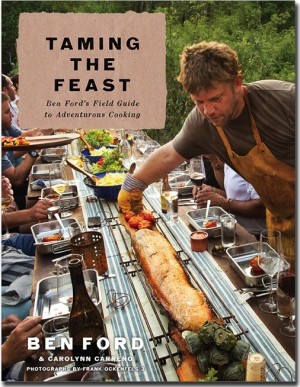 Were you interested in food and cooking as a kid?
Were you interested in food and cooking as a kid?
I have always loved food. My whole family cooked and we gardened. Some of my earliest memories are from time spent in the garden as a kid. Gardening was the first step in me becoming a chef. It was a natural progression from raising my own vegetables to then wanting to cook with them. It became a lifelong passion, and I make it my mission to get kids’ hands in the soil by helping to start gardens in our public schools. The garden is still where I find the most inspiration, and why not? It offers the most diversity on the plate. Colors, textures — there is a lot more going on than when you just focus in on a protein. I think it’s a much better place to start when planning a meal. This process keeps me from falling into the same trap that most chefs encounter when their starting point is to figure out what is going to go well with their steak. It’s not that it’s wrong; it’s just that through that process the chefs find themselves relegating the vegetable to a side dish instead of elevating it on the plate. I feel it’s disingenuous to the vegetables. But then again, what else would you expect from a California chef?
What are some of your childhood food memories?
Traveling to Japan when I was 12 really was where I lost my inhibitions surrounding food. It was amazing, and I experienced so many new foods and new flavors — I was on overload.
You’ve said your mom was an avid gardener and cook. How did her approach influence your cooking today?
My mother cooked simple foods. She still, to this day, made the best roast chicken I have ever had. Great pumpkin pie, soups and stews. I think the largest influence has been my involvement in the process. I still like getting as close to the garden or, in most cases, to the farm as possible. Helping close the gap between the fields and the back door of our kitchens or our homes – it makes me feel more rooted to know where my food comes from.
You come from a creative family – how has that influenced your career?
There was freedom to explore in my family, and my parents had amazing friends: writers, musicians, all great conversationalists. To this day, I still try to surround myself with artists rather than just chefs. I find it’s in those situations that I am the most creative.
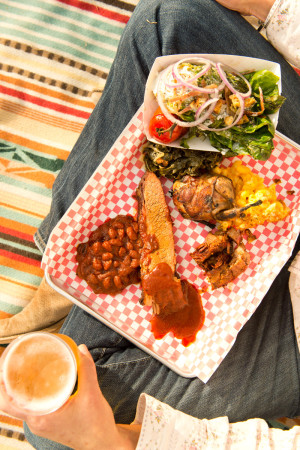 How would you describe your food and cooking philosophy?
How would you describe your food and cooking philosophy?
Simple food using great ingredients, done with little manipulation. My gardening and foraging backgrounds are reflected in my root-to-flower philosophy, where I use plants during all the stages of life. I also have a snout-to-tail philosophy. Not long ago, butchery was becoming a lost craft, and being among the pioneers of the snout-to-tail philosophy in the country we were in the unique position to help resurrect it. In my kitchens, we support a culture of reciprocal teaching and learning. With the craft of cooking, there are parts of my trade that are still only passed down by word of mouth in a professional kitchen. Those are the skills of the master chef. I am in the business of building chefs, and it starts with teaching them how to cook. How to touch, feel, smell, and taste your way to great food are the foundations of a great chef — not how long to boil a bag in a perfectly controlled environment. Lastly, I am a locavore. If I can find it locally I will generally use it over a product that gas travelled vast distances. Not because of the carbon footprint so much as the fact that those ingredients are reflective of my terroir and they make sense for the foods I am cooking in Southern California.
You went to school and wanted to be a baseball player. How did you begin a cooking career?
After an injury I took stock in my future and decided to follow my passion for cooking. Los Angeles wasn’t the culinary mecca it is today, so I headed north. I found my way into my first kitchens the hard way: knocking on the back door and asking for a job. Thank goodness it wasn’t long before I found a home at Chez Panisse and the rest is history.
What was the most important thing you learned working with Alice Waters at Chez Panisse?
I was done with fine dining. Thank goodness I was just a step ahead of a world that was beginning to feel the same way. My restaurant, Chadwick, was considered one of the finest restaurants in Los Angeles. It was groundbreaking in many ways. It’s a concept based on community; you can never lose sight of that. With our expansion I am finding communities in unconventional places. What is most important is having a concept that supports that culture. I like that it’s all-inclusive. My dining room is a true reflection of the diversity of Los Angeles, and I love it.
Why did you decide to write a book about big feasts?
There wasn’t a book out like that. It’s something that could appeal to the person who loves to throw big parties, but also to the inquisitive type who’s interested in this kind of cooking. I wanted to make it approachable, so each feast is scaled for the home cook; there’s a “tamed” version of everything. It’s a book reflective of where I am right now in my cooking style. I started getting interested in raising animals about six years ago, and I have a relationship with a rancher who predominantly brings in whole animals to the restaurant. That kitchen culture helps connect cooks to what they’re working with. With whole animal cookery, obviously it’s hard to force in a small oven, so it pushes you outside to wood-fired cooking. It’s also fun to document techniques that had never been documented before.
Tell us about the first big feast you cooked. Are there any other memorable ones you can tell us about?
It was roast duck for 80 in the north woods of Wisconsin. I was a teenager and was already fairly handy at the stoves, and I decided it would be nice to make a duck dinner for my family in our cabin. Well, word in our community spread that I was making dinner – a duck dinner, nonetheless – and the party grew and grew. We rented tables, chairs and tents, and I went to the task of cooking for the town out of that cabin kitchen. Needless to say, the dinner went off perfectly, but the oven had seen better days.
How do you get other people involved? Why is it important to work together?
Because people love to be a part of something. It’s a part of our communal sprit. I always noticed how guests gather in the kitchen – well, this brings the kitchen to them.
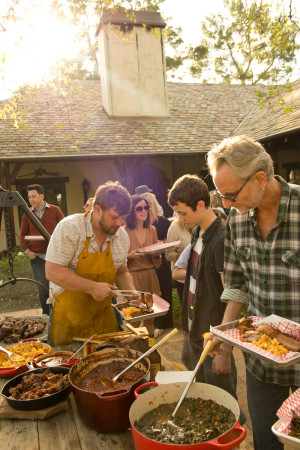 The feasts aren’t just about the food, but about the atmosphere. What are you best tips and ideas for making it a special event?
The feasts aren’t just about the food, but about the atmosphere. What are you best tips and ideas for making it a special event?
One of the things people forget when planning a party is how important the environment is – it really can influence the food their guests are enjoying. This is especially true when you take the meal outdoors. Every sense is awakened when you are outdoors.
What did you learn about construction from watching your dad, a carpenter?
I learned almost everything from him. The rest is self-taught or picked up on a job site. My dad used to take me through construction sites (frequently not his own) and show me how the floor joists were hung or how the carpenters were framing a particular wall.
What are some of the projects you’ve built over the years?
I have been a part of building things all my life. It started with some pretty elaborate tree houses and progressed to big boy houses. Carpentry was one of the jobs I turned to when I was trying to eke out a living as a young cook in San Francisco. Since then it’s been channeled into projects like my cured meat room. However, when things fail at the restaurant I am frequently still the best man for the job.
How would you describe the recipes in Taming the Feast?
The recipes really reflect the cooking I am best known for: hearty, full of flavor, possibly with a twist on the traditional. The recipes are easy increased for a large feast or left “tamed” for smaller groups.
What are a couple of your favorites?
All the recipes in the book have a personal and a logistical reason for being included, but I do have a couple of favorites. The paella recipe — we won some competitions with that one. I love the brisket recipe and the bacon-wrapped quail. The clambake in general – the idea behind that most people had never established an appreciation for my their terroir of southern California. Bringing a clambake into a backyard, I had to decide whether to do it above ground or below ground. I wanted to build contraptions so that it could be done in an urban area. I staged it in an alleyway in LA, and that was a lot of fun. Instead of lobsters we used Dungeness crab, and instead of linguisa we used chorizo, and we used corn and artichokes. It was all cooked inside a wood oak wine barrel designed for that purpose. I wasn’t expecting it, but that combination with the artichokes was the best thing I’ve ever had in my life. They are alll really solid recipes; a lot of effort went into testing them out well. And there are DIY elements; people can do it in their own kitchens, but it would be fun to see how people react to the big feasts outdoors.
What ingredients do you look forward to all year?
Green garlic, morel mushrooms and ramps. Some of the wild plants I forage for are my favorites. I love the adventure in looking for plants. Figs and avocados are also high on my list. A great avocado or fig in season is just ridiculous.
Do you cook at home? What’s a typical family dinner?
A typical dinner in our house is anything but typical. Everybody in our family cooks — even our three-year-old spends time in the kitchen. I think it’s important. I’ve broadened my kids’ palates, so we’ll make sushi one night, or we’ll do paellas or burgers. We get thematic at home and have a lot of fun with it. I try to do things the kids can have fun with.
If you weren’t a chef, what would you be doing?
I would be an architect or in agriculture.
Try recipes from Ben Ford here!

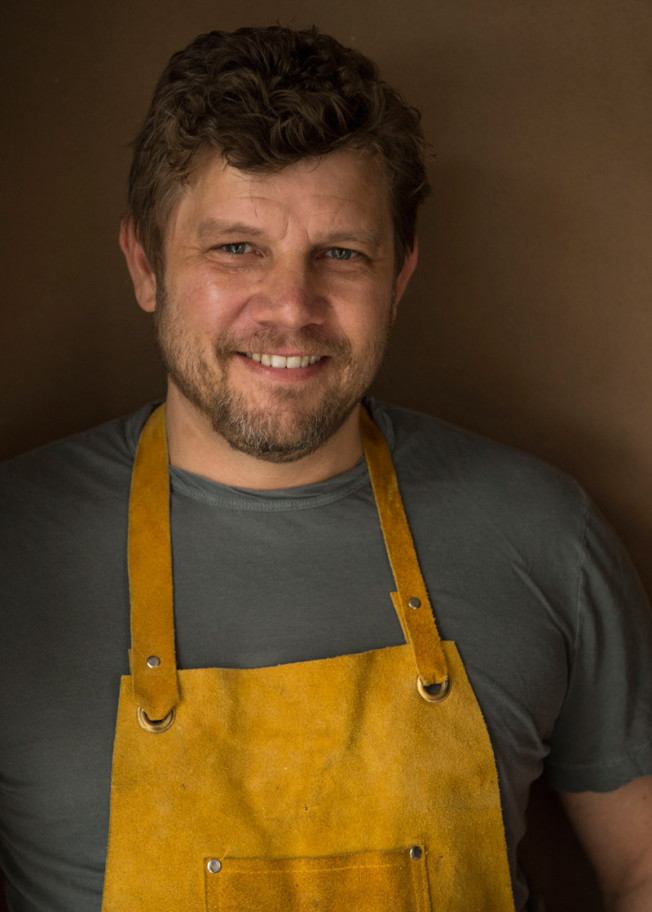
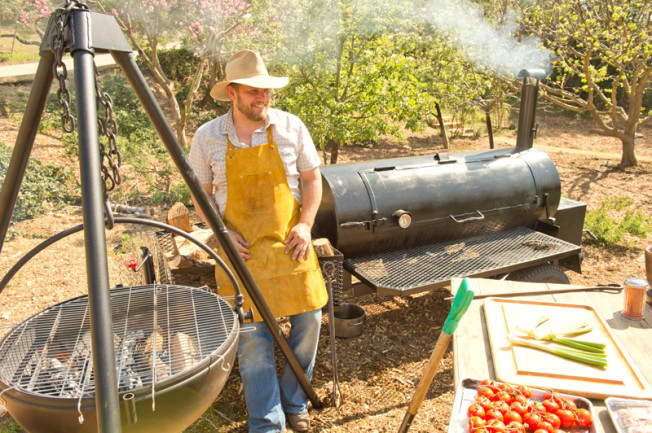
10 comments
[…] indah saat duduk di sekitar meja besar dengan banyak makanan dan sedikit terlalu banyak minum. Saya ingin mereproduksi pengalaman itu,” katanya dalam sebuah wawancara dengan Williams Sonoma setelah buku itu dirilis. […]
[…] have great memories of sitting around big tables with lots of food and a little too much to drink. I wanted to reproduce those experiences,” he said in an interview with Williams Sonoma after the book’s release. “The […]
[…] с большим количеством еды и немного лишним пить. Я хотел воспроизвести этот опыт“- сказал он в интервью Williams Sonoma после выхода книги. […]
[…] have great memories of sitting around big tables with lots of food and a little too much to drink. I wanted to reproduce those experiences,” he said in an interview with Williams Sonoma after the book’s release. “The […]
[…] have great memories of sitting around big tables with lots of food and a little too much to drink. I wanted to reproduce those experiences,” he said in an interview with Williams Sonoma after the book’s release. “The […]
[…] have great memories of sitting around big tables with lots of food and a little too much to drink. I wanted to reproduce those experiences,” he said in an interview with Williams Sonoma after the book’s release. “The […]
[…] have great memories of sitting around big tables with lots of food and a little too much to drink. I wanted to reproduce those experiences,” he said in an interview with Williams Sonoma after the book’s release. “The […]
[…] حول طاولات كبيرة مع الكثير من الطعام وقليل من الشرب. كنت أرغب في إعادة إنتاج تلك التجاربقال في مقابلة مع ويليامز سونوما بعد إصدار الكتاب. يمكن […]
It’s fantastic to see how travel changed his perception on food. It’s also very exciting to see his passion for passing along his knowledge. Chef Ford will be sharing his experience firsthand in Hawaii at Chef Fest http://foodandwinehualalai.com/ at the Four Seasons Hualalai. Definitely thinking of checking it out!
Ben Ford has quickly become a culinary hero of mine and I have started to widen my outdoor cooking repertoire based upon some of things he’s been doing. Down here, in Australia, outback cooking has really come a long way and the kinds of dishes that I’ve prepared in the Australian bush has a kind of synergy with the style Ben has become known for.
He is the alchemist.